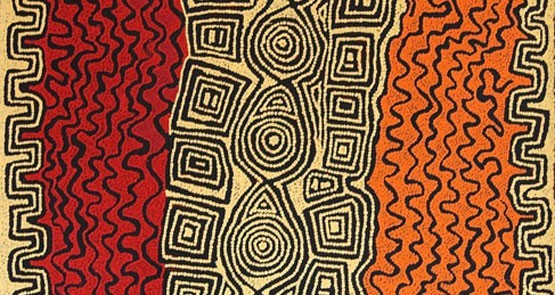
‘Untitled’ by Patrick Tjungurrayi, exhibited by Suzanne O’Connell Gallery
The Senate estimates hearing of the Environment and Communications Committee yesterday was long and taxing for those involved. The ABC’s Mark Scott was grilled at length about NBN coverage. NBN boss Bill Morrow was asked about the faltering progress of his multi-technology network. A number of national cultural institutions appeared to explain that they would have to lay off staff after recent funding cuts. Greens Senator Scott Ludlam examined how two Hollywood studios ended up with tens of millions of taxpayer dollars.
And several hours into the proceedings, the Arts Ministry’s Sally Basser was questioned in detail about a single arts grant under Arts Minister Mitch Fifield’s new Catalyst fund, the successor to former arts minister George Brandis’ disastrous National Program for Excellence in the Arts.
The grant was $485,480 to the Suzanne O’Connell Gallery in Brisbane, for a large group exhibition of Aboriginal and Torres Strait Islander art it is taking to Monaco’s Oceanographic Museum.
Labor’s Catryna Bilyk spent quite a bit of time questioning Basser on the grant, asking when the application was received, what partners were involved, and whether Tony Abbott had written a letter of support. Basser took most of the questions on notice, though she did confirm that the former prime minister had not, in fact, written in support of the application.
The project itself looks to be a worthy one. Fifty-one indigenous artists, many from the Torres Strait, will be commissioned to create artwork for a European museum, and their work will be transported there, installed, and marketed. This is the sort of project that Labor normally champions.
It’s a mark of how politicised arts funding has become under the Coalition that a grant like this has ended up a subject of estimates. Individual arts grants do occasionally come up at estimates hearings, but in general, most of the time politicians confine themselves to matters of process.
But George Brandis’ sneak attack on the Australia Council last year changed that. The arts sector is now bitterly divided between the haves and the have-nots, and every single grant is being watched closely by politicians and industry players.
Who can blame them? Under Brandis, the Arts Ministry gave out more than $1 million to the Australian World Orchestra (AWO), despite that orchestra’s former board member, Michael Napthali, working as Brandis’ key arts adviser when the grants were awarded. (When Crikey approached Brandis about Napthali’s role in the AWO funding decisions, we were told that Napthali was “not involved” in the decision to fund the orchestra.)
There was also the $275,000 grant given to controversial record label Melba Recordings, which neither Brandis nor Melba told anyone about.
And with overall arts funding shrinking, we’re in a negative-sum game. Every dollar awarded via Catalyst to projects like the exhibition in Monaco comes at the expense of the Australia Council’s ongoing operations — with small-to-medium companies and independent artists the ones taking the brunt of the austerity.
Under the Coalition, arts policy has become fiercely contested. The problem for companies and artists applying to Catalyst is that they are participating in a funding round widely loathed by the broader arts sector.
Arts industry figures that Crikey has spoken to since the announcement of the Catalyst grant awards have been gobsmacked at just how much money is being distributed to a commercial gallery.
For instance, $485,000 is more than any single small-to-medium company can apply for to the Australia Council for a project. A sum like that could fund perhaps two or three youth arts companies over the space of several years.
This is more than a trivial comparison. In the wake of the funding cuts from Brandis and Fifield, the Australia Council changed the rules of its organisational funding. The largest sum an arts organisation can apply for to produce a single project is $100,000.
Crikey approached the Suzanne O’Connell Gallery for further details about the Monaco grant.
The total budget for the project is $1.24 million, of which “art work creation and production” totals $581,435. Transport, travel, installation, marketing and project management costs make up the rest:
“Art work creation and production = $ AUD 581,435
Art work transport & installation = $ AUD 225,233
Marketing and public programs = $ AUD 160,740
Project management costs = $ AUD 131,570
Artists & arts centre coordinator & agents & travel = $ AUD 145,838
TOTAL BUDGET = $ AUD 1,244,816”
A spokesperson for the gallery told Crikey that “the largest portion of the costs go to the making of the artwork and presentation of the work (including art materials and workshops with the artists to create the work, transportation for freight to and from the museum, as well as installation and dismantling).”
“Obviously, transporting large scale artworks to Europe is not a small undertaking,” the spokesperson said.
And this is true. Ambitious international projects of this nature are costly.
What the Catalyst grant to Suzanne O’Connell reveals is that ambition of this nature is simply not possible under the smaller and more austere Australia Council that has emerged from the trauma of the Brandis years. For cash-strapped arts organisations looking on in envy at the Oceanographic Museum grant, the scale and the vision of a project like this must be difficult to take.
The lucrative grant given to Suzanne O’Connell suggests that arts funding has become a two-class system, with a lucky few rewarded via the Arts Ministry, while the majority will struggle when applying to a diminished Australia Council.








Crikey is committed to hosting lively discussions. Help us keep the conversation useful, interesting and welcoming. We aim to publish comments quickly in the interest of promoting robust conversation, but we’re a small team and we deploy filters to protect against legal risk. Occasionally your comment may be held up while we review, but we’re working as fast as we can to keep the conversation rolling.
The Crikey comment section is members-only content. Please subscribe to leave a comment.
The Crikey comment section is members-only content. Please login to leave a comment.